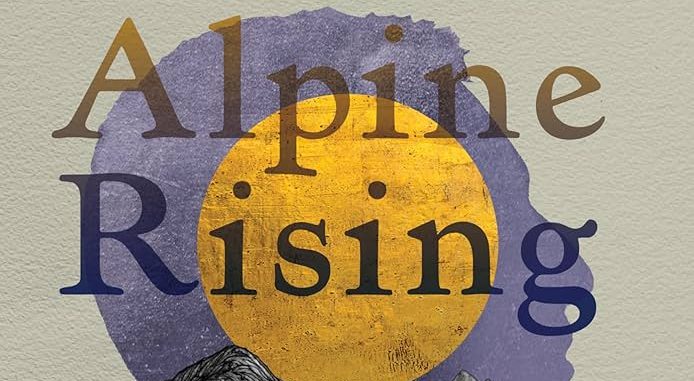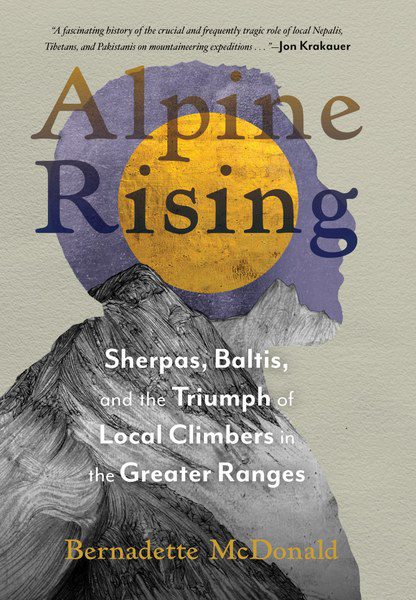Book Review for Alpine Rising: Sherpas, Baltis, and the Triumph of Local Climbers in the Greater Ranges
"McDonald lays bare the truth and doesn’t mince words, just as this subject matter demands"

Alpine Rising: Sherpas, Baltis, and the Triumph of Local Climbers in the Greater Ranges is a 265-page book by Bernadette McDonald published by Mountaineers Books in 2024.
There are stories that need to be told.
And that is why writers write.
From the first paragraphs of Alpine Rising, the reader senses their author, Bernadette McDonald, understood these stories were long overdue. Having written seven books on topics related to Himalayan climbing, and edited several more, McDonald is well qualified for the task. And now published three years after the coveted first winter ascent of K2 was accomplished by a team of 10 highly skilled Nepali climbers who walked the final steps to the summit in unison singing their national anthem – a moment shared with millions around the world via social media – the time for this book is certainly ripe.
Some of the earliest stories are more than a century old. McDonald has opened the vault, blown off the dust, respectfully unpacked the stories of men who accomplished remarkable actions, but who were too-often relegated to the shadows of official historical accounts – when they were mentioned at all. The pain of many of their experiences, though, remains timeless.
Through the telling of these stories from a contemporary perspective, admittedly as “seen through the lens of a woman from the Canadian Rockies,” accompanied by the benefit of decades having passed, McDonald exposes how many well-funded expeditions undertaken under the banner of national pride and self-perceived superiority during the first half of the 20th century didn’t just use the locals who had lived under the flanks of those mountains for generations to enable those foreigners to reach summits they intended to “claim” for their own home countries, but they routinely abused them unapologetically.
The chapter titles say a lot: Ten Rupees a Digit.
McDonald lays bare the truth and doesn’t mince words, just as this subject matter demands. Among these distressing accounts, she is necessarily blunt while respectfully relating the woeful story of Amir Mehdi. Taking the reader onto the highest ridges of K2, she deftly contrasts the triumph of the Sherpas on K2’s first winter ascent in 2021 with the horrible events that transpired during the first ascent in 1954. When Italy’s Walter Bonatti was ordered to carry 80 pounds of oxygen high up the mountain to support the designated summit team, a task he and his teammates knew he couldn’t manage alone, he enlisted the help of a high-altitude porter from Pakistan’s Shimshal Valley, Amir Mehdi. Arriving at the location of the high camp, they found nothing.
A voice from above shouted down for them to leave the cylinders and descend – a deliberate act meant to prevent the strong Bonatti from attempting the summit with them. Deciding it was too late to descend safely, Bonatti hacked out a platform for himself and Mehdi to spend the night. But wearing boots two sizes too small, Mehdi suffered through the night as his feet froze, then just before dawn he staggered down the mountain while Bonatti watched. Mehdi reached the next camp 350 metres lower where he was cared for by a Hunza porter – on the very same day that Compagnoni and Lacadelli summitted K2 to great worldwide fanfare. Mehdi was transported to hospital, where doctors amputated all his toes and one-third of one foot, sentencing him to a life of pain and
dependence on his family.
“In the years since his death in 1999, Mehdi has occasionally been hailed as an “unsung hero,” the man who was “betrayed,” a “martyr of K2,” McDonald writes. “But during his lifetime, Amir Mehdi was simply treated as collateral damage.” While this not the only dark story in Alpine Rising, What McDonald does so well is to bring these characters to brilliant life, not as fragmentary people, but as real persons – talented, skilled, brave, imperfect, and at times – justifiably – reluctant to do their employers’ bidding. While balanced accounts are mostly unavailable through the earlier decades, when possible, she shares their thoughts about their treatment, and their desires to be respected as equals.
We also learn how some of the High Altitude Porters (HAPs), acted heroically, as Ang Tharkay did in 1950, when he carried severely frostbitten
Maurice Herzog for miles after he became the first person to summit an 8000-metre peak. It’s sentences such as this where McDonald shines, giving an extra depth of interpretation, when after quoting from Ang Tharkay’s memoir she absolutely questions the near-worshiping tone of his statements regarding Herzog, suggesting, “it’s worth considering to what extent Ang Tharkay’s words may have been filtered through or edited by his Western co-author.”
Progressing through the decades, the reader benefits from increasing availability of information and material, including published accounts and recently recorded interviews with Sherpa, Balti and others who are living. With that, McDonald’s subjects become more interesting, deeper, more nuanced, and more intricately human.
And that’s the beauty of this book.
Progression is the theme, and reality play its role, as shortcomings and benefits of socio-economic, and political influences are revealed as multi-layered. She includes how Nepal’s Sherpas have benefitted in ways the Pakistanis have not, including the role government support plays. Of course, while anyone trekking or climbing in the Khumbu today may become tired of the steady buzz of helicopter traffic, that sound is music to those earning a living from heavy tourist visitation. The progression is not all rosy; like life, there are blemishes. Potholes. Fisticuffs.
The book culminates in full chapters each on Mingma G and Nimsdai – both very colourful, multi-faceted and fully individual high-achieving professional climbers. They live connected to the modern world in ways their predecessors never could have – made easy through social media, and the ubiquitous presence of cell phones, visible in the hand or pocket of every local high altitude guide decked in top-of-the-line technical gear, as well as non-climbing porters who carry unimaginably heavy loads on the trails between villages and base camps using a traditional tumpline. Throughout these pages, McDonald fulfils her stated intent to show the Sherpa, Balti, Ladakhi, Hunza, Astori, Magar, Bhotia, Rai, and Gurung alpinists as distinct, from different countries and cultures.
At times painful, even infuriating, on other pages Alpine Rising is hilarious, sharp witted, tender, deeply insightful, and always, absolutely timely. – Lynn Martel is an award-winning writer based in the Canadian Rockies. Find her book Stories of Ice: Adventure, Commerce and Creativity on Canada’s Glaciers here.



